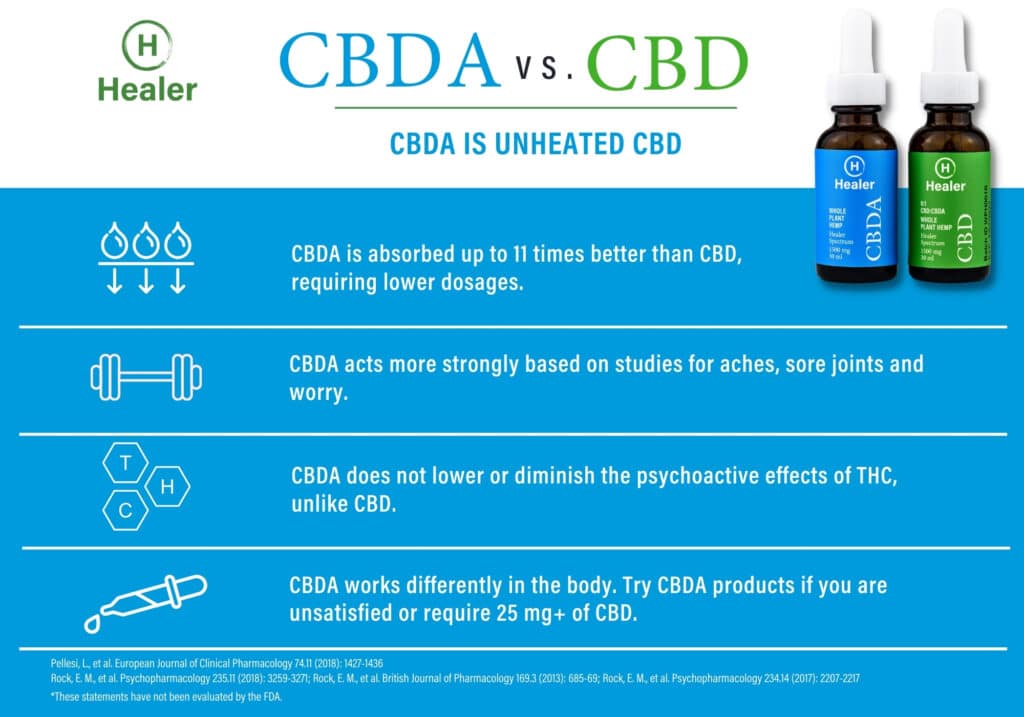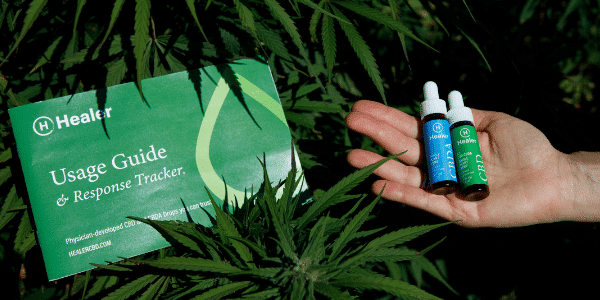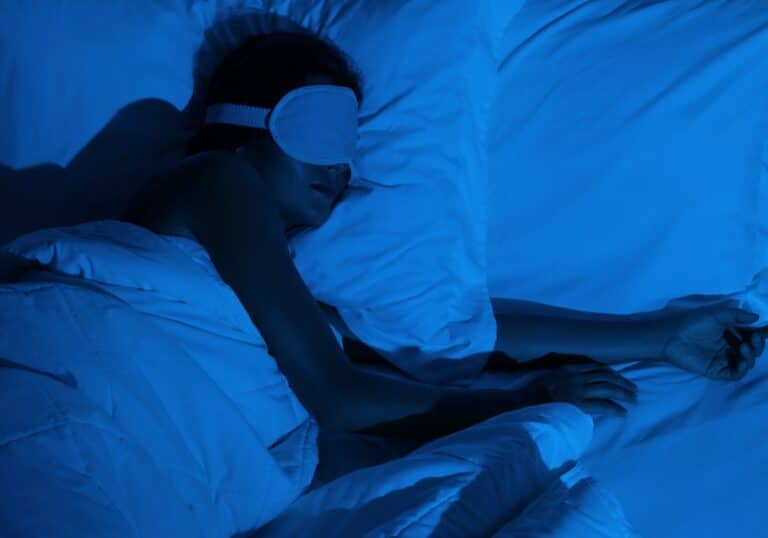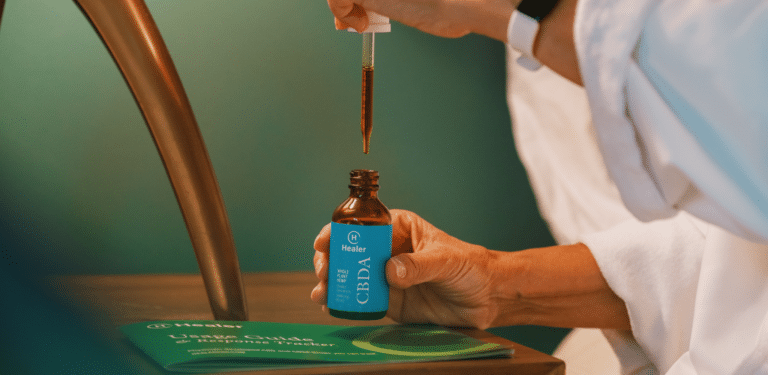CBDA vs CBD: What’s the difference?
Posted on June 22nd, 2020 to CBDA by Healer Staff Writer
What Is CBDA?
CBDA is the precursory acidic cannabinoid found in plants that belong to the cannabis family. CBDA shares some properties with CBD, but the two may have different biological actions within the body. Additionally, one of the primary benefits of CBDA is that the cannabinoid may be more bioavailable in the body and therefore more powerful than CBD.
Follow along to learn more about the distinction between CBDA vs CBD, as well as how to utilize each cannabis compound in your pursuit of wellness.
What are the main differences between CBDA vs CBD?
The main differences between CBDA vs CBD are: CBD can be extracted from the flower and leaves of hemp varieties, while CBDA is the raw, unheated precursor of CBD.
Cannabidiol (CBD) is a well-known component of hemp with a diverse range of potential benefits. Many are surprised to learn that the hemp plant does not directly produce CBD. The plant actually produces cannabidiolic acid (CBDA) which converts to CBD slowly at room temperature, or rapidly when exposed to high temperatures.
Both CBD and CBDA are non-impairing, non-intoxicating cannabinoids that help support body and mind. They are just two of over 100+ cannabinoids and other physiologically active constituents in Cannabis sativa.
CBDA and CBD share many physiologic properties, but also have some important differences:
- CBDA is more easily absorbed (up to 11 times) when taken by mouth, compared to CBD. [1]
- CBDA and CBD both have anti-ache properties, but may act via different mechanisms in the body. For example, unlike CBD, CBDA has been shown to decrease the activity of the COX-2 enzyme, an enzyme responsible for increasing soreness.[7]
- CBDA may be more potent than CBD for some applications based on studies of rodent models of stress [5], and aches [3]. We don’t know if similar results translate to humans yet, but it is possible that CBDA may be more effective than CBD at lower doses.
- CBDA is unlikely to mitigate the adverse effects of THC, a common usage of CBD. While many people appreciate the combined effects of CBD and THC, some find that CBD weakens the beneficial effects of THC and may prefer CBDA.
How does CBDA impact the body compared to CBD?
In many ways, CBDA works similarly to CBD by influencing the endocannabinoid system and other biological systems within our bodies. But, CBDA has many important differences that make it even more powerful, namely CBDA is better absorbed (5-11 times better)[1] and acts more strongly in the body regarding pain, sore joints and worry.
You’ll see better results at lower dosages when using CBDA products (or whole plant hemp CBD products that contain CBDA) compared to pure or nearly-pure CBD isolate. If you have tried CBD without much success, don’t assume CBDA won’t help.
Which is best for me, CBDA or CBD?
We recommend starting with Healer CBD, which contains mostly CBD and about 15% CBDA, along with the Healer Spectrum of naturally occurring minor cannabinoids, terpenes, flavonoids, and other important phytonutrients.
While the human research on both CBD and CBDA is still emerging, early findings show that even small amounts of CBDA, like those found in our CBD formula, can have significant physiologic effects.
However, you should start with our CBDA product if:
- You want to try CBDA’s more powerful benefits or know you respond better to CBDA.
- You’ve tried CBD in the past in moderate to high amounts (25-50mg) and have been unsatisfied with the results
- You’re using THC and you don’t want your hemp product to decrease its effects
Further Understanding The Benefits of CBDA
Most people are familiar with CBD oil, which is very popular these days for its health and wellness benefits. But there’s another lesser known cannabinoid called CBDA that is gaining attention from consumers and the scientific community as early findings show that even small amounts of CBDA can have significant beneficial physiological effects.
CBDA has many important differences to CBD that make it even more powerful, namely
- CBDA is better absorbed (5-11 times better)[1]
- CBDA acts more strongly in studies.
- CBDA does not lower or diminish the benefits of THC like CBD.
Because high-quality human research on these cannabinoids is still emerging and there are still many unknowns, in this post we’ll share what you need to know about this CBDA oil.
CBDA Benefits:
- May relieve aches and soreness*
- May improve sleeplessness*
- Supports mood, promotes resilience to stress and relieves irritability*
- Promotes alertness and clear thinking*
- May enhance performance and recovery from exercise*
*These statements have not been evaluated by the Food and Drug Administration.
Video: Find Your Formula: Using CBDA with Other Cannabinoids
What is the most effective way to take CBDA?
Placing CBDA oil drops under your tongue (sublingual administration) is the best way to ensure fast and efficient absorption and minimize delays associated with digestion. CBDA oil drops may be added to food or drinks, too. However, you may require a larger amount and it may take longer to feel the effects. CBDA oil drops can be applied directly to the skin as a topical or added to your favorite cream or beauty product.
What are CBDA oil drops?
CBDA oil is generally concentrated and used as the active ingredient in cannabis tinctures, vaporizers, topicals, capsules, edibles and other products. Oils infused with CBDA are the best delivery method for taking CBDA.
High-quality CBDA oil is harder to find because acidic cannabinoids are more difficult to extract and stabilize, but those currently available come in several forms: isolate, broad spectrum, full spectrum and Healer spectrum:
- CBDA Isolates contain CBDA alone. All of the other beneficial plant components are removed using a chemical process. Since these highly processed formulas don’t absorb as well, nano-emulsifiers are added to boost their effectiveness, and the consumer typically requires higher amounts.
- Broad Spectrum CBDA products contain CBDA along with some of the naturally occurring compounds from the hemp plant, without THC or THCa. These oils are also processed using chemical reactions to remove THC and THCA.
- Full Spectrum CBDA products include the legally allowed trace amounts of THC and THCA (a maximum of 0.3% THC). While the term ‘full spectrum’ is meant to describe products that retain all of the beneficial plant compounds, many products labeled full spectrum actually only contain THC while others add in terpenes from other plants.
- Healer Spectrum CBDA products are made using Healer’s patented nano-filtration technology to contain the full range of naturally occurring plant compounds including acidic and other minor cannabinoids, the legally allowed trace amounts of THCA and THC (less than 0.3%) , and the plant’s original terpenes, flavonoids and phytonutrients.
Frequently Asked Questions
What are the benefits of taking CBDA oil?
Many people are now switching to CBDA oil especially if CBD oil hasn’t worked for them or they need high amounts of it 25 – 50+ mg per use. CBDA oil is better for aches, pains, and is less stimulating which is better for night time use.
Adding or switching to CBDA can actually lower the amount of CBD and cannabinoids you use every day AND significantly increase the benefits.
CBDA oil also does not diminish the effects and benefits of THC products like CBD does. That’s why many people combine CBDA with THC to increase their benefits and use CBD to diminish THC’s effect if they take too much or have side effects associated with THC like grogginess, irritability, and fatigue.
Since everyone responds uniquely to CBD and CBDA, it is important to try them in the proper way to understand what one or both can do for you.
How do I take CBDA oil?
When using CBDA oils, tinctures, drops or edibles, your first goal is to find the number of milligrams (mg) of total cannabinoids (CBDA) you need to feel the benefits per each use. This may be evident quite early, or it may take up to 2 weeks or longer to discover.
The idea is to start very low (i.e., 5 mg per use), and increase your daily usage amount by 5 mg every 2 days until you start feeling results. Then, stop increasing and keep using the same number of milligrams or drops.
For many people, the amount that provides modest benefits in the first couple days will, after consistent use, provide more and more benefit over time. After you find the amount that works for you, and if you notice that the effects wear off too early in the day, this is when it’s beneficial to add more uses per day. A great resource for more detailed instructions is Healer’s Usage Guide.
Also, to increase absorption so you can take less, human studies have shown that CBD gets absorbed up to 5x better when taken with some food that contains fat or oil [6].
It’s wise to keep track of how much you take, how many times a day you take it, and your results in a journal. Be sure to rate your symptoms daily to see if they are getting better or worse.
Get Dr. Sulak’s free, clinically validated, step-by-step Usage Guide and Response Tracker© to help eliminate confusion and ensure your success with CBDA oil.
How will CBDA oil make me feel?
When you take CBDA products, they should taste like a freshly juiced cannabis plant, producing a peppery sensation in the back of the mouth and throat. This sensation is likely the feeling of the CBDA being absorbed, as one of CBDA’s mechanisms of action is similar to capsaicin, the active constituent in hot chili peppers that activates the receptor involved in regulating aches and discomfort.
If the taste is too strong for you, a sip of water will quickly remove the sensation. Or, you can also try adding CBDA drops to drinks and foods or purchase capsules. If the product you’re taking doesn’t produce that sensation, there may not be enough of this powerful cannabinoid in it.
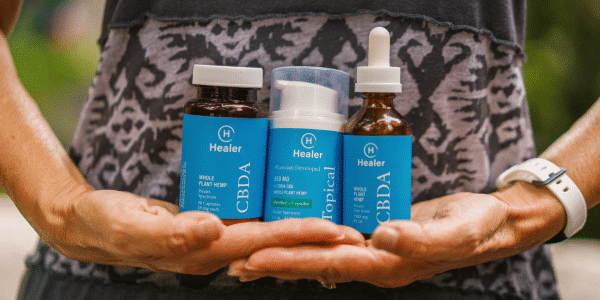
Where can I buy high quality CBDA oil drops?
Because the Food and Drug Administration (FDA) doesn’t regulate CBD products the same way it does drugs and supplements at this time, you must be a savvy consumer.
Whenever possible, look for locally grown, artisanal produced, and laboratory tested products. If purchasing online, it can be hard to know what retailer to trust. Hemp-based CBDA consumers should buy from companies that provide copies of an independent laboratory analysis (via a COA or certificate of analysis) that correlates with the batch in question.
See Healer’s Certificate of Analysis (COA)
What are the most important things to look for when buying CBDA oil?
CBDA and CBD products vary widely in their potency, purity, and safety. Unfortunately, several scientific studies and investigative reports have found inaccurate labeling and contamination with pesticides, heavy metals, and other toxins in at least 50% of the products tested.
Here are a few tips:
- When purchasing a CBD or CBDA product, seek out accurately labeled products providing third-party certificates of analysis that correspond to the product batch.
- Look to see how much CBDA is in 1 ml of oil. Seek products that have a high level of CBDA, i.e. 20-25 mg/ml or more versus CBDA oils that may only have 1-10 mg/ml of oil.
- Is it refrigerated? As you learned above, acidic cannabinoids neutralize over time. Refrigeration slows down the process and preserves them.
Is there a difference between CBDA oil, CBDA tincture, CBDA drops?
CBDA oil, CBDA tincture and CBDA drops all refer to CBDA in a form that can be taken sublingually, added to food or applied directly to the skin. The word ‘tincture’ has become an all-purpose phrase to describe liquid cannabis preparations, but the true definition of tincture is an extraction in an alcohol solution.
What is a cannabinoid?
Cannabinoids are the most studied group of naturally occurring chemical compounds in cannabis and hemp, mainly due to their wide range of beneficial effects in mammals. Cannabinoids are referred to as acidic or neutral, depending on their chemical state. Acidic cannabinoids are non-intoxicating cannabinoid compounds that come straight from the cannabis and hemp plants. Over time, through heat and pressure, acidic cannabinoids ‘neutralize’ meaning they lose their carboxylic acid functional group (a process called decarboxylation) and are referred to as neutral cannabinoids.
What are the most common cannabinoids?
THC and CBD are best known cannabinoids. These two neutral cannabinoids (You can tell that they’re neutral cannabinoids, because there’s no “A” for acid in their names.) are just two of over 100+ acidic and neutral cannabinoids in the hemp plant Cannabis sativa.
How does CBD work and what is the science?
CBD influences the ECS by decreasing the uptake and breakdown of anandamide, one of the compounds we produce that stimulates our cells’ cannabinoid receptors (CB1 and CB2). CBD has also been shown to modulate the action of CB1 receptors, which could help in situations of excessive CB1 activity.
Beyond its influence on the ECS, CBD works at several other sites in the body correlating with health benefits:
- CBD stimulates the “capsaicin receptor” (TRPV1 channel) known for its impact on aches and discomfort. Unlike capsaicin, which is commonly used in topical preparations, CBD does not cause a burning sensation.
- CBD stimulates the serotonin 5-HT1A receptor, which is involved in cognition, mood, anxiety, sociability, impulsivity, sex drive, and arousal.
- CBD likely stimulates the adenosine A2 receptor, which is involved in anti-soreness and neuroprotective activity.
Learn more: CBD Dosage – How Much CBD Should I Take?
What is the Endocannabinoid System? Why is it important?
The Endocannabinoid System (ECS) is a biological system in the human body involved in establishing and maintaining human health. In each tissue, the endocannabinoid system performs different tasks, but the goal is always the same: homeostasis, the maintenance of a stable internal environment despite fluctuations in the external environment. Cannabinoids promote homeostasis at every level of biological life.
Your body’s ECS has been hard at work since before you were born to maintain balance at a cellular level, helping you heal from illness and injury. Present in all the tissues and organs of the body, the ECS regulates the function of the immune, cardiovascular, musculoskeletal and nervous systems, and thus has a profound influence on every aspect of our health, including:
- Aches & Discomfort
- Mood and worry
- Resilience to stress
- Cognition
- Signaling
- Gut function
- Tissue recovery after exercise or injury
- And more…
CBD and CBDA can enhance the activity of the ECS and act on several other physiologic targets involved in health and healing.
It’s hard to believe the stories of CBD helping with such a wide variety of issues, but CBD’s versatile benefits correlate with the critical role that the endocannabinoid system (ECS) plays in our health.
Learn more about the Endocannabinoid System with Dr. Sulak.
How safe is CBD?
Human studies with repeated high doses of CBD (1,500 mg twice daily for 1 week) have failed to demonstrate any toxic or serious adverse effects.
What are the common side effects of CBD?
People who use excessive amounts of CBD may report loss of appetite, nausea, diarrhea, restlessness, and disturbed sleep. If you suspect any of these side effects with your CBD use, you should contact your doctor and reduce the amount you’re using or try taking a break from CBD.
What are the benefits of CBD and CBDA whole plant hemp formulas?
Healer Drops are whole plant hemp formulas with CBD, CBDA and the Healer Spectrum of the plant’s beneficial acidic and minor cannabinoids, terpenes, flavonoids and phytonutrients. They may help to naturally:
- Helps to relieve aches & soreness*
- Support mood, promote resilience to stress, and relieve irritability*
- Promotes alertness and clear thinking*
- May enhance performance and recovery from exercise*
Research has shown that whole plant hemp formulas, like Healer CBD and CBDA drops, have a better effect on the body than taking CBD alone. As our Certificates of Analysis (COAs) show, our Healer Spectrum delivers to you many of the plant’s original cannabinoid, terpene and flavonoid profiles. This allows you to get better results per drop compared to others, especially a CBD isolate product.
*These statements have not been evaluated by the Food and Drug Administration.
What are the benefits of using CBD and CBDA at bedtime?
Many people successfully use CBD and CBDA before bed and in the middle of the night, while others report that their use during the day helps them to relax and sleep more at night. CBD may disturb sleep in a small number of people when taken directly before bed.
First, try CBD and CBDA during the morning and middle of the day for 3–5 days before trying it right before bedtime. If you find CBD and CBDA energizing and want to try it at bedtime, you may find that increasing your usage amount by 2x–4x may help with relaxation and sleep.*
*These statements have not been evaluated by the Food and Drug Administration.
Does CBD and CBDA interact with medications?
Patients taking pharmaceutical medications should discuss CBD with their medical provider prior to taking.
CBD may interact with certain medications, including the anticoagulant warfarin, the seizure medications valproic acid and clobazam, and other drugs metabolized by the liver enzymes CYP3A4 and CYP2C19.
Potential Drug interactions may occur with the following medications:
- topiramate
- rufinamide
- n-des-methylclobazam (an active metabolite of clobazam)
- zonisamide
- eslicarbazepine
- valproic acid
- Warfarin
- amiodarone
- cyclosporine
- diltiazem
- fluconazole
- haloperidol
- sertraline
- tetracycline antibiotics
- tacrolimus
- verapamil
Online drug interaction checkers now include CBD, so if you’re in doubt, you can check https://www.webmd.com/interaction-checker/default.htm for potential interactions using the name Cannabidiol.
What to expect from Healer CBD and CBDA drops?
Since Healer CBD products work with the body’s Endocannabinoid System (ECS), your response will be personal based on your body’s specific needs. Many people will experience immediate benefits from Healer CBD products while for others the beneficial effects will continue to build over time 30-60+ days.
Take the guesswork out of using CBD with our clinically proven, free step-by-step Usage Guide & Response Tracker©. Let Dr. Sulak guide you to better health.
Dr. Sulak recommends starting with Healer CBD drops, capsules and topical if you are new to CBD and CBDA.
However, you should start with Healer CBDA products if:
- You want to try CBDA’s more powerful benefits or know you respond better to CBDA
- You’ve tried CBD in the past in moderate to high amounts (25-50mg) and have been unsatisfied with the results
- You’re using THC and you don’t want your hemp product to decrease its effects
Final Thoughts on CBDA vs CBD
In conclusion, CBDA holds great promise in the world of cannabis-based wellness. It shares similarities with CBD but offers some unique advantages, including better absorption and potentially greater potency for certain applications. CBDA’s impact on aches, soreness, and worry has shown promising results in animal studies, and while more research is needed in humans, it presents an exciting avenue for exploration.
When choosing between CBDA and CBD, it’s important to consider your specific needs and responses. Some individuals may find CBDA to be more effective, especially if they haven’t experienced the desired results with CBD alone. However, it’s crucial to consult with a healthcare provider before incorporating either compound, especially if you’re taking medications or have underlying medical conditions.
Incorporating CBDA into your wellness routine may offer a valuable addition to your cannabinoid regimen. As research continues to unfold, we anticipate more insights into the potential benefits and applications of this fascinating cannabinoid.
Always Consult Your Doctor
We encourage you to consult your physician or healthcare authority before you start, stop, or change your health regimen, and to determine what course of therapy is right for you. Always seek consultation if you are pregnant, nursing, have or suspect you have a medical condition, or are taking any medications to discuss potential interactions or complications. The information presented here is not a substitute for or alternative to information from your healthcare providers.
Explore Dr. Sulak’s CBD and CBDA webinar recording
Dr. Sulak answers the questions frequently asked about CBD and CBDA by patients and health providers, and presents research.
Topics Covered:
- CBD effects in the body
- How does CBD work?
- How is CBDA different?
- CBD for worry
- CBD for aches and opioid use
- CBD or CBDA for sleeplessness?
- Topical CBD
- Trouble with CBD products
- Common mistakes with CBD
- Strategies for success with CBD
- Selecting a safe and reliable product
[1] Pellesi, L., et al. European Journal of Clinical Pharmacology 74.11 (2018): 1427-1436.
[2] Anderson, Lyndsey L., et al. Journal of natural products 82.11 (2019): 3047-3055.
[3] Rock, E. M., et al. Psychopharmacology 235.11 (2018): 3259-3271.
[4] Rock, E. M., et al. British Journal of Pharmacology 169.3 (2013): 685-69
[5] Rock, E. M., et al. Psychopharmacology 234.14 (2017): 2207-2217.
[6] Taylor, Lesley, et al. CNS drugs 32.11 (2018): 1053-1067.
